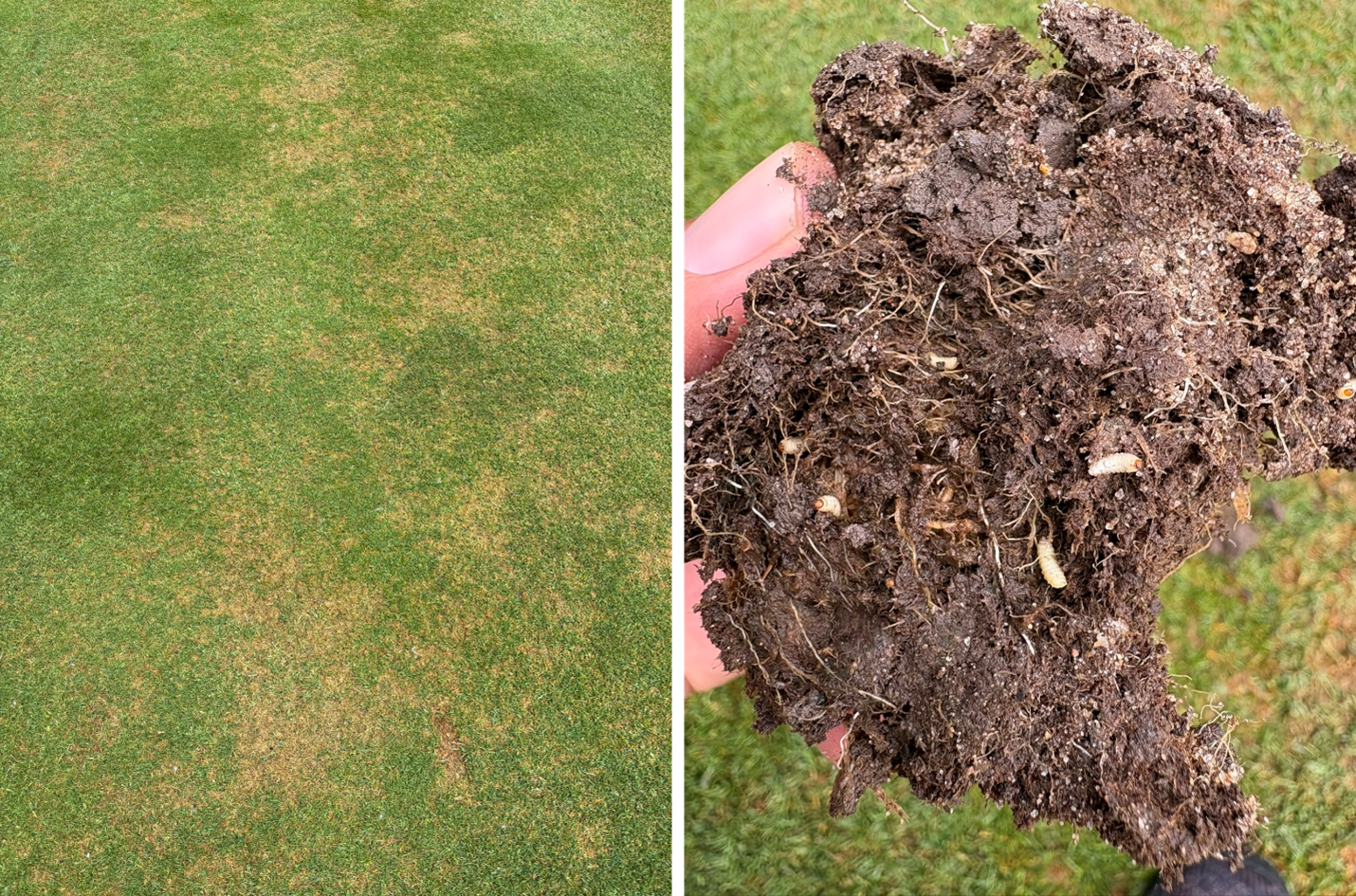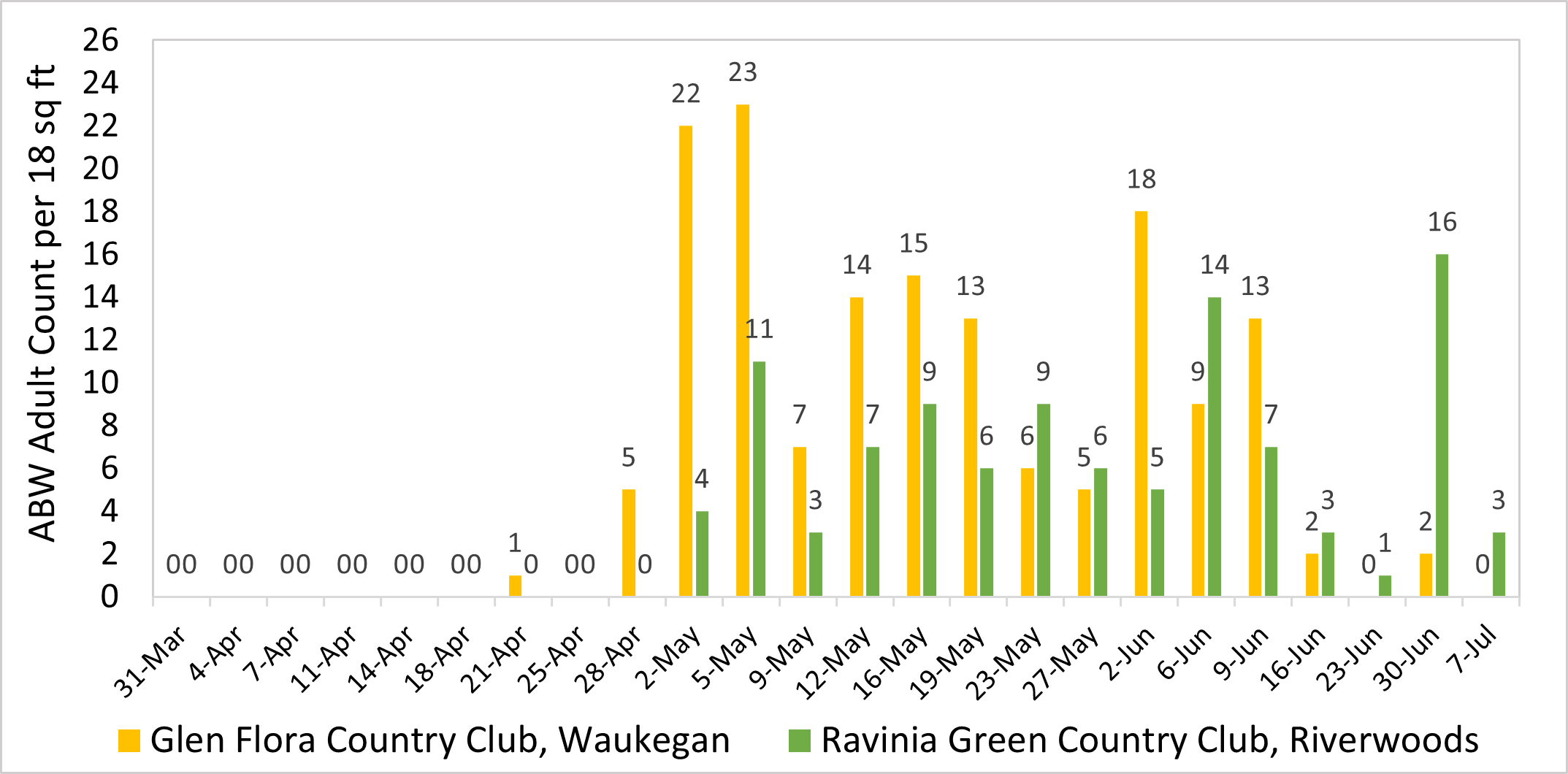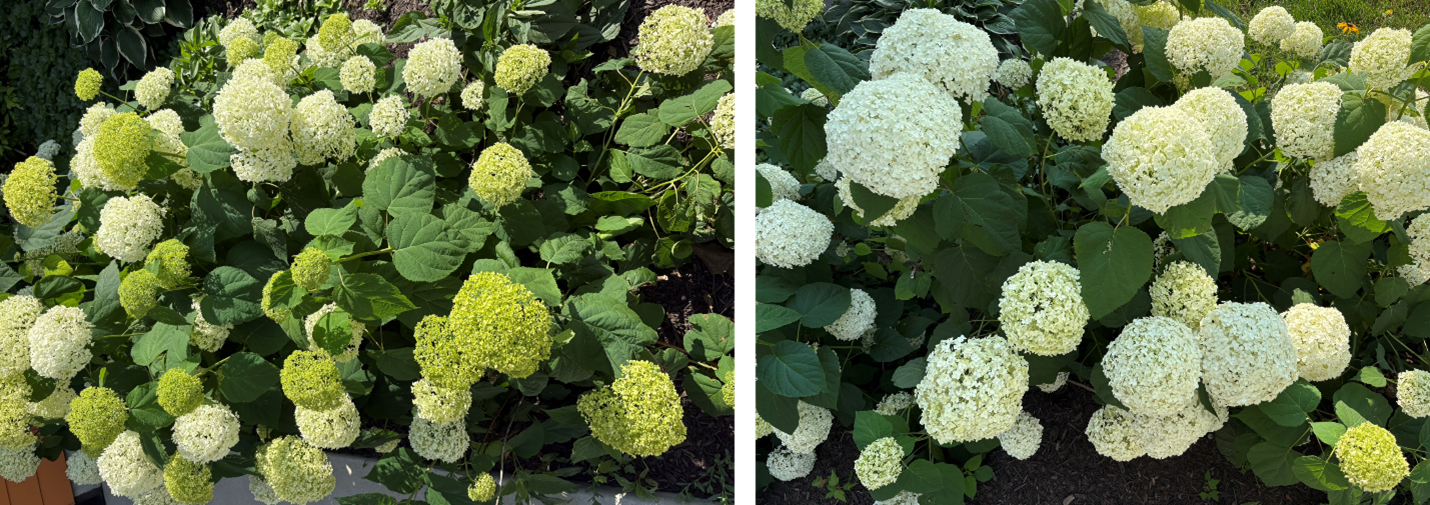First ABW damage detected in 2025 season at North Suburb Chicago golf courses
In late June and early July, notable annual bluegrass weevil (ABW) larval damage was detected at both Ravinia Green Country Club (RGCC) and Glen Flora Country Club (GFCC) in the Chicago area, though not on the greens under investigation. At RGCC, damage was found on the fairway of hole no. 7, where a large, irregularly shaped yellow-orange patch appeared in the Poa annua turf on June 27 (Figure 1). Sampling revealed heavy larval pressure, with 15 larvae found in a single 2-inch plug, and lab analysis estimated approximately 130 larvae per ft2. Most were 5th instar larvae, though other instars and younger, brown-colored adults were also present. At GFCC, damage was observed in the collar region of Green 17, with significantly less severity. On July 4, soap flushing yielded 32 adult weevils in a 9 ft2 area, including several reddish-brown individuals, indicating that these were newly emerged adults. At both locations, the peak emergence of the next generation of ABW adults is anticipated within the next 1 – 2 weeks. Significant larval turf damage at RGCC coincided with the growing degree day (GDD) of 753 on June 27, and at GFCC with the GDD of 843 on June 30.
 Figure 1. (Left) ABW larval damage in Poa annua fairway 7, and (Right) ABW larvae in turf sample core. Ravinia Green Country Club, Riverwoods. Singh. June 27.
Figure 1. (Left) ABW larval damage in Poa annua fairway 7, and (Right) ABW larvae in turf sample core. Ravinia Green Country Club, Riverwoods. Singh. June 27. Adult counts on the investigated green declined significantly after mid-June, with the exception of a spike of 16 adults per 9 ft2 at RGCC on June 30 (Figure 2). On the same day, 4th and 5th instar larvae were detected in the collar region of Green 17 at RGCC, while no larvae were found in either the fairway or collar samples at GFCC. As of July 6, the accumulated growing degree days (GDD) are 1004 at RGCC and 997 at GFCC.
 Figure 2. ABW adult count in 18 ft2 of sampled turf using the soap-flushing method in two north suburbs, Chicago, IL.
Figure 2. ABW adult count in 18 ft2 of sampled turf using the soap-flushing method in two north suburbs, Chicago, IL. The onset of significant turf damage coincided with the early to full bloom of smooth hydrangea (Hydrangea arborescens ‘Annabelle’) (Figure 3).
 Figure 3. Smooth Hydrangea with (Left) early bloom on June 27, and (Right) full bloom on July 7. Warrenville, IL. Singh
Figure 3. Smooth Hydrangea with (Left) early bloom on June 27, and (Right) full bloom on July 7. Warrenville, IL. SinghFirst ABW damage detected in 2025 season at North Suburb Chicago golf courses
In late June and early July, notable annual bluegrass weevil (ABW) larval damage was detected at both Ravinia Green Country Club (RGCC) and Glen Flora Country Club (GFCC) in the Chicago area, though not on the greens under investigation. At RGCC, damage was found on the fairway of hole no. 7, where a large, irregularly shaped yellow-orange patch appeared in the Poa annua turf on June 27 (Figure 1). Sampling revealed heavy larval pressure, with 15 larvae found in a single 2-inch plug, and lab analysis estimated approximately 130 larvae per ft2. Most were 5th instar larvae, though other instars and younger, brown-colored adults were also present. At GFCC, damage was observed in the collar region of Green 17, with significantly less severity. On July 4, soap flushing yielded 32 adult weevils in a 9 ft2 area, including several reddish-brown individuals, indicating that these were newly emerged adults. At both locations, the peak emergence of the next generation of ABW adults is anticipated within the next 1 – 2 weeks. Significant larval turf damage at RGCC coincided with the growing degree day (GDD) of 753 on June 27, and at GFCC with the GDD of 843 on June 30.
 Figure 1. (Left) ABW larval damage in Poa annua fairway 7, and (Right) ABW larvae in turf sample core. Ravinia Green Country Club, Riverwoods. Singh. June 27.
Figure 1. (Left) ABW larval damage in Poa annua fairway 7, and (Right) ABW larvae in turf sample core. Ravinia Green Country Club, Riverwoods. Singh. June 27. Adult counts on the investigated green declined significantly after mid-June, with the exception of a spike of 16 adults per 9 ft2 at RGCC on June 30 (Figure 2). On the same day, 4th and 5th instar larvae were detected in the collar region of Green 17 at RGCC, while no larvae were found in either the fairway or collar samples at GFCC. As of July 6, the accumulated growing degree days (GDD) are 1004 at RGCC and 997 at GFCC.
 Figure 2. ABW adult count in 18 ft2 of sampled turf using the soap-flushing method in two north suburbs, Chicago, IL.
Figure 2. ABW adult count in 18 ft2 of sampled turf using the soap-flushing method in two north suburbs, Chicago, IL. The onset of significant turf damage coincided with the early to full bloom of smooth hydrangea (Hydrangea arborescens ‘Annabelle’) (Figure 3).
 Figure 3. Smooth Hydrangea with (Left) early bloom on June 27, and (Right) full bloom on July 7. Warrenville, IL. Singh
Figure 3. Smooth Hydrangea with (Left) early bloom on June 27, and (Right) full bloom on July 7. Warrenville, IL. Singh